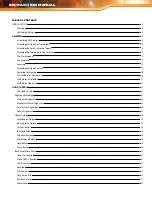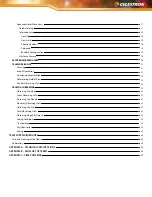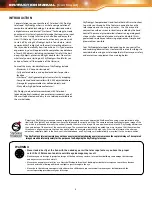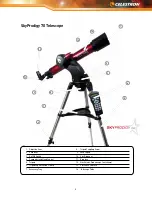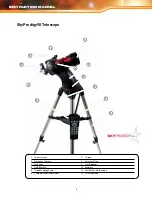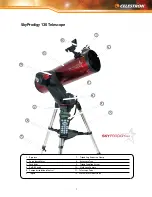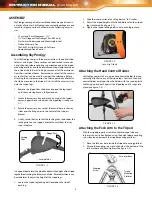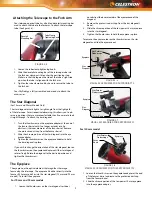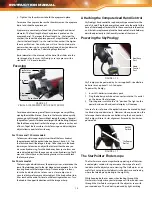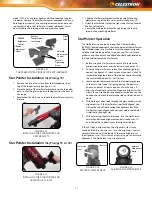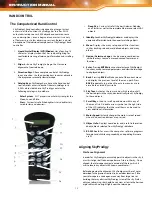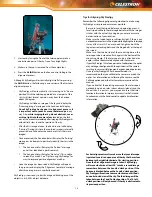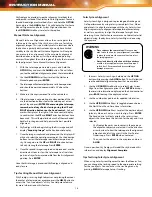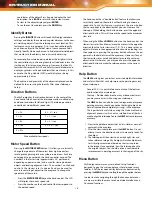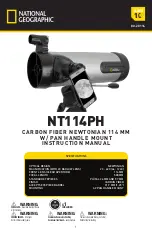
1. Start out by facing the front of the telescope towards an
unobstructed part of the sky, free of any bright lights.
2. Make sure the cap is removed from the camera lens.
3. Press the ALIGN button on the hand control to begin the
alignment process.
Although SkyProdigy will essentially align itself after pressing
the ALIGN button, the following is an overview of the StarSense
alignment process:
•
SkyProdigy will automatically start moving to its “home
position”. With the telescope pointed at a clear part of the
sky, it will slew (move) upwards, away from the horizon
about 25 degrees.
•
SkyProdigy will take an image of the sky and display the
“Acquiring Image” message on the hand control display.
Once SkyProdigy has begun its alignment process, it
is important not to touch or move the telescope in any
way. Also, while imaging the sky, do not obstruct, cover
or shine light into the camera lens located on the fork
arm of the mount. Immediately after imaging, SkyProdigy will
automatically slew to another portion of the sky.
•
After the first image is taken, the hand control will display
“Sensing”. During this time the captured image is internally
processed and will display the number of stars that were
imaged.
•
Once processed, the hand control will display the “Solving”
message as it attempts to positively identify the stars in the
image.
1. The hand control will display the “Solved” message
once it has identified a positive match.
2. The hand control will display “No Solve” if it is unable
to identify a match. See “Tips for using SkyProdigy” for
ways to improve positive alignment matches.
•
Once the image has been solved, SkyProdigy will repeat
this process and display the “Alignment Complete” message
after three images are successfully acquired.
SkyProdigy is now ready to start finding and tracking any of the
objects in its 4,000+ object database.
Tips for Aligning SkyProdigy
Remember the following alignment guidelines to make using
SkyProdigy as simple and accurate as possible.
• Be sure to level the tripod before you begin alignment. A
level tripod will help the telescope better match the images
it takes with the actual sky and give you a more accurate
determination of your location.
• Make sure the tripod legs are sufficiently tight. If there is any
noticeable movement in the tripod while aligning the telescope,
it may affect results. You may need to tighten both the
leg extension locking bolts and the hinge bolts at the top of
the tripod.
• Make sure that the bottom of the mounting bar on the
telescope tube is mounted flush against the bottom of the
mounting clamp. If the telescope tube is attached at an
angle, it will not be accurately aligned with the camera.
• If your SkyProdigy 130 telescope is out of collimation, the optics
may no longer be aligned with the optical axis of the camera
resulting in unsuccessful alignments or poor pointing accuracy.
• Once your SkyProdigy 130 has been collimated, it is
recommended that you calibrate the camera to match the
optics. For information on calibrating the camera, see the
Calibrate option under the StarSense Camera section of the
manual.
• If you notice that the pointing accuracy of the telescope is
noticeably worse on solar system objects (planets and the
Moon) than it is on stars, you may need to reset the time/
location information to improve accuracy. Use the Time and
Location menu in the hand control to update time/location
information.
For best alignment results, make sure that your telescope
is pointed towards an open area of the sky that has a
clear
horizon to the right (clockwise)
of its starting position.
Once the first alignment image is taken, SkyProdigy
will move clockwise at least 90° to take a second image
somewhere between the 4 and 6 o’clock position. If the
horizon is blocked between the 3 and 6 o’clock position,
SkyProdigy will continue to move clockwise until it finds
an unobstructed view of the sky. The third image will be
taken between the 7 and 9 o’clock position. The 10 to 12
o’clock position will only be used if the sky is obstructed in
its previous position.
13
12
6
7
8
3
4
5
1
2
9
10
11


